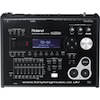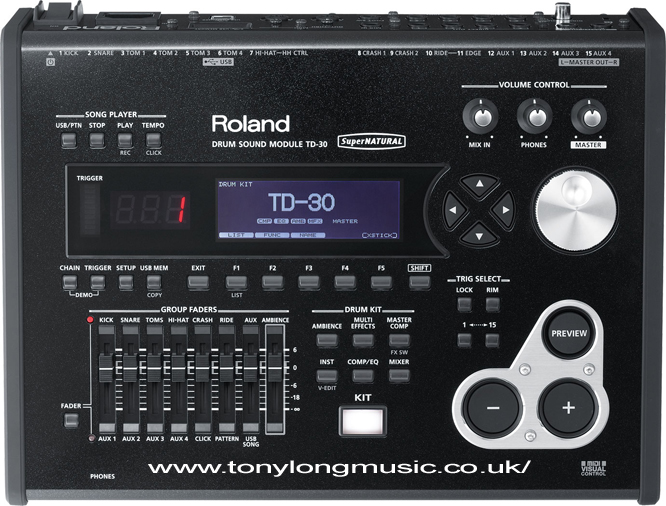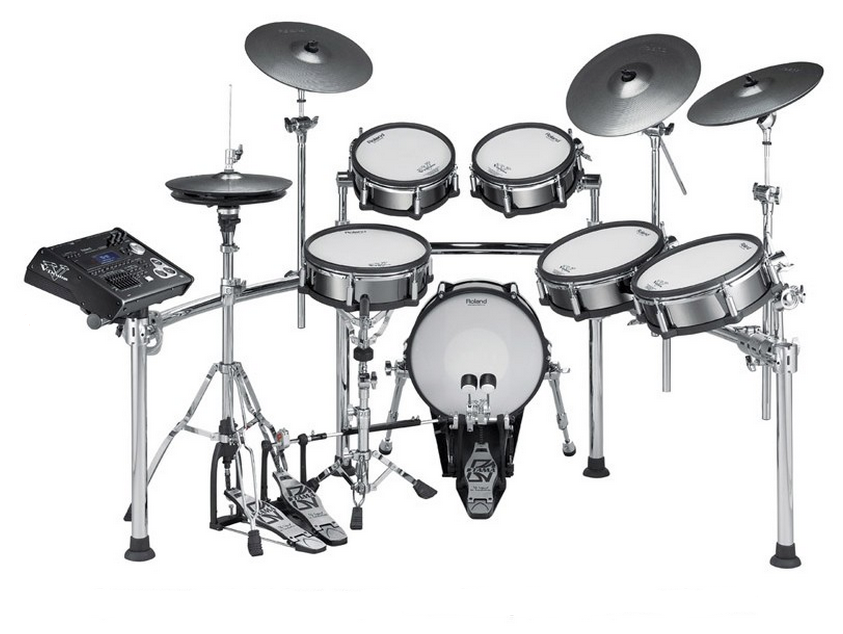ROLAND TD-30 MODULE REVIEW
Posted on Tue 18 September 2012 in entries
You can read more reviews like this, listen to Tony’s productions, purchase synth patches and more at his personal site ->Tony Long Music.
ROLAND TD-30 MODULE - INTRODUCTION
If (like me) you've been interested in electronic drums since they first entered the instrument market, you may well have owned a Roland kit at some point. In fact, I happen to have owned a small handful of them in my time, working my way up from my early TD-7 through to the TD-10 and TD-20 modules and recently moving onto the new TD-30.
Affording a £5000 or more kit is not for the faint hearted. I have still not achieved it and I have made as many compromises as I possibly could along the way to build up a decent kit whilst keeping the cost as low as possible. The primary part of an electronic kit is without doubt the module or 'brain' as it sometimes called. Although this is another big outlay, it did not seem too bad after the sale of my expanded TD-20 module.
ROLAND TD-30 MODULE - HOW DOES IT IMPROVE ON THE TD-20?
The first thing that caught my eye on the TD-30 was that it has the ability to play mp3s and wav files from a USB stick. A very basic need I know, but it was something that was going to provide convenience and instant gratification and something I desperately wanted on my TD-20. Late at night, without disturbing anyone, you can put on your headphones and play along to all of your favourite tracks.
Ok, this is one advantage and believe me there are many more, but perhaps this question is best answered at the end of this review as we explore the pros and cons.
ROLAND TD-30 MODULE - POWER UP
After connecting up the TD-30 and powering on, you are now presented with a new screen that says 'Auto Off function is On - The TD-30 will automatically turn off if not played or used in any way after 4 hours'. You can of course disable this if you wish.
Everything else looks very familiar and there are not too many immediate differences from the TD-20 module. Eager to play the first kit, I gave it a go. Disappointingly, I quickly realised that I can't just accept the default parameters and trigger settings and that I will have to make changes for both the pads that I am using and my playing style.
ROLAND TD-30 MODULE - NEW PADS, TRIGGERING AND MODELLING
Along with the release of the TD-30, Roland have also released some new drums - the PD-128 and the PD-108, which each exhibit improved rim sensitivity. I have played on these drums in a music shop and they sound and feel great, but trying to compare that experience with the feel of the PD-125 pad at home is very difficult. I think that if I had a PD-128 and a PD-125 pad side by side, I may notice a difference and no doubt I would prefer the PD-128, but when I increased the rim sensitivity on my PD-125, I felt that it was very close to the PD-128 that I had played in the shop.
To keep my potential £5000 cost down, I did not buy Roland Toms, instead opting to purchase Pintech Mesh head drums at less than a third of the cost of the Roland equivalents. What I noticed about setting the trigger type for these drums was that it was much easier on the TD-20 module. The TD-30 really did not like PD-108 or PD-105 as a trigger type for my Pintechs and I experienced incorrect triggering between head and rim. After a few days of adjusting many parameters, I tried the PDX-100 as a trigger type and they all worked very well. Having got my kit set up the way I wanted, I must say the whole thing now sounds and feels much more responsive.
Roland has used their SuperNATURAL Behaviour Modelling Technology in the TD-20 module, which they first introduced with the V-Piano. This now gives a new level of realism and expression on the TD-30. This does not just apply to the physical modelling of the instruments, but to how you play, giving you true-to-life, expressive sounds in realtime.
ROLAND TD-30 MODULE - KITS AND SOUNDS
As well as 262 backing instruments, the TD-30 module also gives you 1101 drum instruments. These are made up of 157 Bass Drums, 187 Snare Drums, 252 Toms, 44 Hi-Hats, 60 Crash cymbals, 18 China cymbals, 6 Stacked cymbals, 70 Ride cymbals, 177 Percussion sounds, 54 drum effects, 34 Other sounds, 12 Claps, 12 Cymbal effects and 18 Melodic sounds.
Roland has always concentrated their efforts on producing real drum sounds and kits, trying to accurately create all of the acoustic nuances created by factors such as different types of wood. Today, many other sounds are used to create rhythms and I like combining other sounds in with an acoustic kit with sounds such as metallic noises like iron or steel, etc. The TD-30 has introduced new sounds that I know I will include in my kit setups and with detuning and use of their new effects, I know that I will also be able to create interesting custom sounds!
I have never liked the Roland toms and to be honest, I found them to be the biggest disappointment on my TD-20. The TD-30 seems to have the same Toms but with the new Ambience and Compression (which we will have a look at in a bit), you can really bring these toms to life, which seemed only previously possible with additional external hardware.
You get 80 more sounds on the TD-30 when compared to the expanded TD-20 or TD-20X. Kit-wise, there are 80 kits with 20 additional empty kit slots. All 100 of them can be over-written and changes you make are instantly saved. Over 20 of these kits have been taken from the TD-20X but in my opinion they sound much crisper with a lot more detail in their sounds. The bit I don't understand is why are they there in the first place? You can actually access all of the TD-20 and TD-20X kits from within the TD-30 module so I think Roland could have made a bit more effort here. Perhaps they will in a future update. My favourite kit is called 'LA Metal' but I have also tweaked this to improve it further.
ROLAND TD-30 MODULE - COMPRESSION, AMBIENCE AND FX
My first play with both Compression and Ambience in the TD-30 module was a very satisfying experience. I could immediately hear such a difference to the sound I was producing when I applied them. I can confirm that in this area, the TD-30 module boasts a massive improvement over the TD-20.
The TD-30 provides a compressor and equaliser that can be specified for each pad, an ambience section for each kit that simulates the acoustics or reverberation of the location in which you're playing the drums, a multi-effects section (giving you 21 different effects for each kit) and a Master Compressor and Master EQ that are applied to the final output of the sound of each drum kit.
The 21 effects are as follows:- stereo delay, filter+drive, reverse delay, auto wah, tape echo, lo-fi compress, chorus, distortion, phaser, overdrive, step phaser, isolator, flanger, ring modulator, reverb, step ringmod, long reverb, pitch shift, saturator, auto pan and super filter.
What I really like about the Ambience section is that it now has its own slider control.
ROLAND TD-30 MODULE - THE HI-HAT
There is quite a lot in terms of design and construction that goes into an electronic hi-hat. Achieving all of the requirements to resemble an acoustic hi-hat is very difficult and very complex. For a start, you have the sound on top of the upper cymbal, the sound on the side of both cymbals and all of the different sounds produced from the closed to the open position. If this is all that was required, then I am sure Roland would have achieved this, but the smooth transition needed between all possible positions from closed to open in all situations of stick technique is where in my opinion, no one has got it perfect yet.
However, Roland is getting better and better at this all the time and I am sure one day they will nail it. For now, they have released the new VH-13, which is basically an enhanced VH-12 with two cymbals. I am not a great lover of two bits of rubber flopping together, which is why I went for the cheaper VH-11 with its single hi-hat pad, designed to give the impression of two. I sincerely hope that they will also improve the VH-11. I tried the VH-13 in a shop and at over £700, this is a very expensive hi-hat that still does not give me what I am seeking, but it is the nearest thing in the world today that does.
ROLAND TD-30 MODULE - SONG PLAY AND PATTERN PLAY
As I have already stated, the song player (allowing you to play along to your favourite mp3s or wav files) is a fantastic addition. It is a shame that you can only put 99 files on your USB stick. This applies to all files, so if you have your TD-30 backup files on this stick it will further limit the number of mp3s or wav files you can have. Therefore, if you are able to get a 1 or 2 MB stick this should be large enough.
The song player also allows you to change the tempo of the song so that you can slow it down to assist with learning the part and you can set up loop points to practice specific sections of the song.
With the on-board sequencer you have 100 preset patterns and space for a 100 user presets. The sequencer is approximately 40,000 notes and six part. You can play back your patterns as a one-shot or loop the pattern.
ROLAND TD-30 MODULE - CONNECTIONS
Looking at the back of the module, along the bottom you have 16 trigger inputs. This is enough inputs for a four-tom kit with three cymbals, bass drum, hi-hat and snare but then there are four auxiliary inputs for you to add what you wish to make a monster of a kit!
As well as the standard stereo master outputs, there are 8 routable direct outs. These can be used to record individual kit parts or output them through a PA. There is also a digital output. You then have a mix input and a footswitch input, a MIDI In Out/Thru connection, a USB port to connect the TD-30 module to a computer and a second USB port to accept the input of a USB memory stick to backup data or play mp3 or wav files. Lastly there is a power lead input and the On/Off switch. Conveniently, around the front of the TD-30 module is a stereo headphone input socket.
ROLAND TD-30 MODULE - CONCLUSION
The Roland TD-30KV kit is without doubt the best electronic kit in the world at present. In terms of tightness, latency and dynamic responsiveness, it is outstanding. In comparison with the TD-20, the TD-30 is much crisper altogether and although it is not, you could be deceived into thinking it is 24 bit. Plus, adding master compression and ambiance can really take your sound to another level.
There is some awesome potential in this module and it is a shame Roland did not make a greater effort in demonstrating this in their preset kits. However, personalising your kits to your own taste and playing style is part of the fun and education in getting to know your new module.
To sum up, the TD-30 gives you: more sounds, SuperNatural sounds, faster processing and more positional sensitivity. Playing along with your favourite songs with the facility to adjust the tempo is priceless. It is a shame you can only have up to 99 files on a stick though.
I am extremely glad I have moved up to the TD-30 and I confidently know that it will grow with me as I tweak here and there and create my own custom setups. If we ever have a TD-50 on the market, it makes me wonder what awesome enhancements and additions it will hold.
For more information on the Roland TD-30 or any electronic drum kit/module, click the links below or give us a call on 01202 597180.
Roland TD-30KV - More Info/Buy
Roland TD-30KV & Accessories Bundle - More Info/Buy
Roland TD-30K & Accessories Bundle - More Info/Buy
View our Range of Roland Electronic Drums
******If you're interested in buying and you have seen it cheaper elsewhere, please call us or use our
As well as receiving our first rate customer service you can also claimmoney off your next purchasewith our loyalty points scheme and receive a3 year warrantyif you sign up to our FREE VIP Club ( click herefor more infomation). Many of our items also come out on a FREE next-day delivery serviceto mainland UK customers, so you won't be left waiting!
Also, if you want to keep up with all our latest offers, competitions, news and videos, why not follow us on FacebookandTwitter**?







